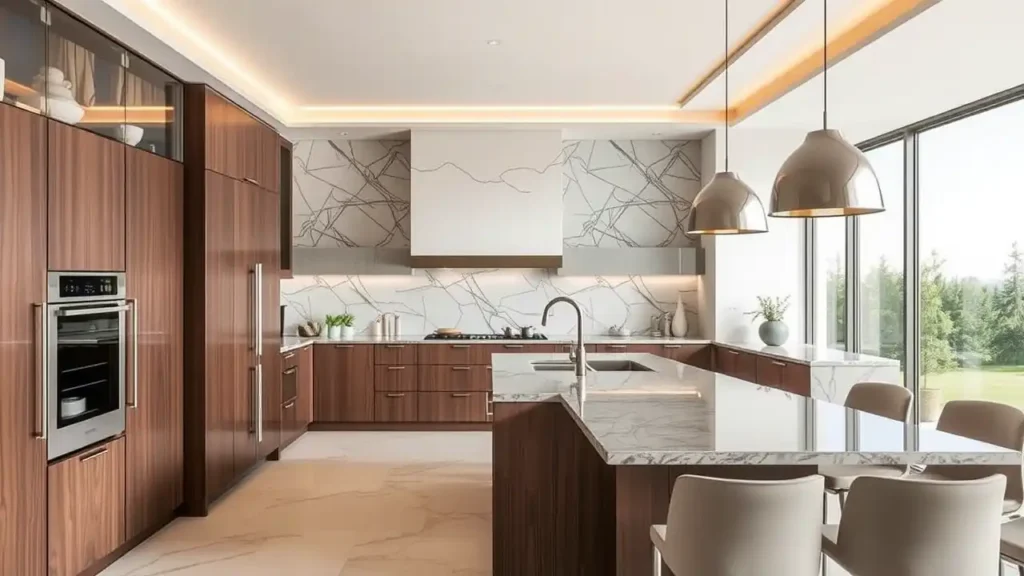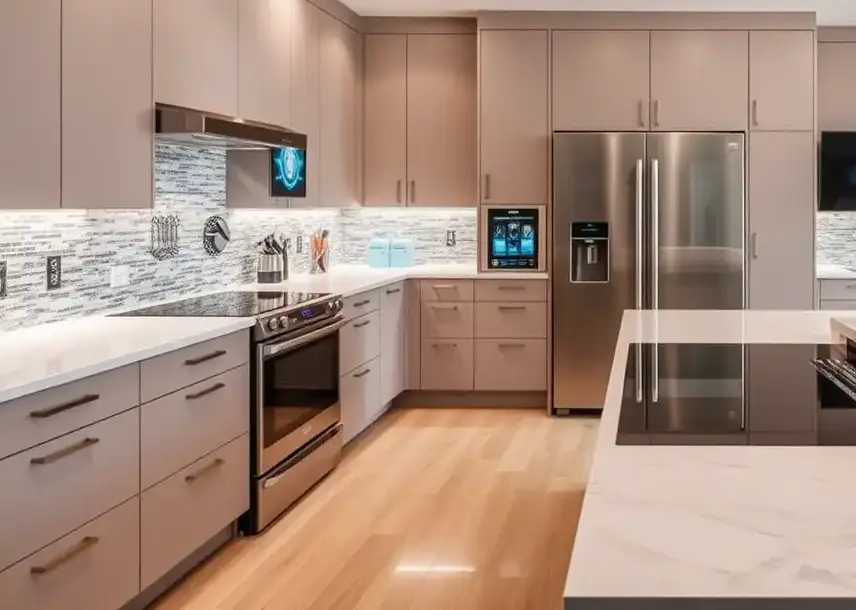In the world of home design, kitchens have evolved from mere functional spaces to true showpieces that reflect personal style, technological innovation, and luxury living.
The concept of a “high-end kitchen” has grown in popularity as homeowners seek to create environments that not only meet their daily needs but also elevate their lifestyle.
But what exactly defines a high-end kitchen? This comprehensive guide will explore everything you need to know about luxury kitchens—what makes them special, how they differ from standard ones, and why investing in one can transform your home.
Contents
- Introduction: The Rise of Luxury Kitchens
- Defining a High-End Kitchen
- Essential Features of a Luxury Kitchen
- The Role of Technology in a Luxury Kitchen
- Benefits of a High-End Kitchen
- Designing a Luxury Kitchen: Key Considerations
- Luxury Kitchen Trends and Innovations
- Cost and Budgeting for a High-End Kitchen
- Maintenance and Longevity of a Luxury Kitchen
- Frequently Asked Questions
- Conclusion
Introduction: The Rise of Luxury Kitchens
Luxury kitchens are no longer reserved for extravagant estates or celebrity mansions. Today, people worldwide are embracing these premium spaces as central hubs for family life, entertainment, and culinary exploration.
A high-end kitchen stands out due to its superior materials, meticulous craftsmanship, advanced technology, and thoughtful design. While any kitchen can serve its purpose, a luxury kitchen goes above and beyond by combining functionality with elegance, creating an atmosphere that feels both inviting and sophisticated.
But what truly sets a high-end kitchen apart? From custom cabinetry crafted from rare woods to state-of-the-art appliances designed for professional chefs, every detail matters.
In this article, we’ll delve into the defining characteristics of a luxury kitchen, examine essential features, discuss the role of technology, and provide practical advice on designing, budgeting, and maintaining such a space.

Defining a High-End Kitchen
A high-end kitchen transcends basic functionality; it becomes a statement piece within the home. It’s defined by several key attributes:
- Premium Materials: Natural stone countertops, exotic hardwoods, and European-style cabinetry.
- Custom Cabinetry: Tailored storage solutions that maximize efficiency while enhancing aesthetics.
- Luxury Appliances: Brands like Sub-Zero, Wolf, Miele, and Viking offer chef-grade performance.
- Smart Home Integration: Voice-controlled lighting, automated climate systems, and connected appliances streamline daily tasks.
Beyond these elements, a high-end kitchen prioritizes user experience through thoughtful design. Every element—from the layout to the fixtures—is chosen to enhance convenience, beauty, and durability.
Essential Features of a Luxury Kitchen
Premium Materials and Finishes
The foundation of a luxury kitchen lies in its materials. Durable yet visually stunning options include:
- Countertops: Natural stone (marble, granite, quartz) offers timeless appeal and unmatched resilience.
- Flooring: Exotic hardwoods or engineered tiles bring warmth and sophistication underfoot.
- Backsplashes: Marble, glass, or quartz tiles add texture and visual interest.
- Cabinetry: Custom-designed units with soft-close drawers, pull-out shelves, and unique finishes ensure both form and function.
Luxury Kitchen Appliances
Appliances play a pivotal role in defining a high-end kitchen. Look for brands known for reliability and performance:
- Sub-Zero Refrigerators: Known for preserving food freshness longer.
- Wolf Ranges: Professional-grade ovens and induction cooktops deliver precise heat control.
- Miele Dishwashers: Quiet operation and energy efficiency make them a favorite among homeowners.
- Viking Cookware: Iconic designs combine aesthetic appeal with exceptional cooking capabilities.
Additionally, smart appliances allow users to monitor and control their kitchen remotely via apps or voice commands.
Functional and Stylish Kitchen Layout
An open floor plan fosters connection between spaces, making the kitchen ideal for gatherings. Key components include:
- Kitchen Island: Provides additional prep space and doubles as a dining area.
- Walk-In Pantry: Keeps clutter at bay while offering easy access to essentials.
- Seating Areas: Bar stools or benches encourage casual meals and socializing.
High-End Kitchen Fixtures and Accessories
Small details make a big impact:
- Pot Filler Faucets: Convenient for filling pots directly on the stove.
- Instant Hot Water Taps: Save time when boiling water for pasta or tea.
- Lighting Solutions: Statement chandeliers, LED under-cabinet lights, and recessed ceiling fixtures create layered illumination.
The Role of Technology in a Luxury Kitchen
Technology has revolutionized the way we interact with our homes, and kitchens are no exception. Modern luxury kitchens integrate cutting-edge innovations to enhance convenience and comfort:
- Voice-Controlled Appliances: Control ovens, coffee makers, and more without lifting a finger.
- Automated Lighting: Adjust brightness levels based on time of day or activity.
- Touchless Faucets: Promote hygiene and reduce wear-and-tear.
- Smart Refrigerators: Track inventory, suggest recipes, and even order groceries online.
These advancements cater to busy lifestyles, ensuring seamless interaction with your kitchen environment.

Benefits of a High-End Kitchen
Investing in a luxury kitchen pays dividends in multiple ways:
- Increased Home Value: A well-designed kitchen boosts property appeal and resale potential.
- Improved Cooking Experience: Advanced appliances and ergonomic layouts simplify meal preparation.
- Elegant Atmosphere: Luxurious finishes and thoughtful design create a welcoming ambiance perfect for hosting.
Whether you’re a passionate home cook or simply appreciate fine design, a high-end kitchen enhances everyday living.
Designing a Luxury Kitchen: Key Considerations
Planning Your High-End Kitchen
Before diving into renovations, consider the following:
- Layout: Optimize traffic flow and incorporate zones for cooking, dining, and storage.
- Budget: Allocate funds wisely across materials, appliances, and labor costs.
- Functionality vs. Aesthetics: Strike a balance between practicality and visual appeal.
Choosing the Right Kitchen Elements
Select styles that align with your tastes:
- Modern: Clean lines, minimalist decor, and sleek surfaces.
- Transitional: Blends contemporary and traditional elements for versatility.
- Classic: Timeless elegance with rich wood tones and intricate detailing.
When choosing appliances, prioritize those that match your cooking habits and complement your overall aesthetic.
Luxury Kitchen Trends and Innovations
Stay ahead of the curve with emerging trends:
- Mixed Materials: Combine metals, woods, and stones for dynamic contrast.
- Eco-Friendly Designs: Sustainable materials and energy-efficient appliances promote environmental responsibility.
- Minimalist Elegance: Simplified silhouettes and hidden hardware emphasize clean aesthetics.
Custom solutions tailored to individual preferences continue to gain traction, allowing homeowners to personalize their dream kitchens.
Cost and Budgeting for a High-End Kitchen
Creating a Modern luxury kitchen requires careful financial planning. Costs vary depending on factors such as:
- Materials: Rare stones and imported woods command higher prices.
- Appliances: Top-tier brands come with premium price tags.
- Labor: Skilled craftsmen charge more for bespoke installations.
- Customization: Unique designs and features increase expenses.
While budgets range widely, expect to spend upwards of $50,000 for a fully equipped luxury kitchen. To stretch your dollar, focus on areas most visible or frequently used.
Maintenance and Longevity of a Luxury Kitchen
To preserve your investment, adopt regular maintenance practices:
- Cleaning Tips: Use non-abrasive cleaners on delicate surfaces and follow manufacturer guidelines for appliances.
- Preservation Techniques: Protect wood finishes with wax treatments and avoid exposing stone to acidic substances.
- Longevity Strategies: Schedule routine inspections to address minor issues before they escalate.
Proper upkeep ensures your luxury kitchen remains beautiful and functional for years to come.
Frequently Asked Questions
Q: Which appliance brands are considered high-end?
A: Sub-Zero, Wolf, Miele, Viking, and Thermador are among the leading luxury brands.
Q: How does a luxury kitchen enhance a home?
A: By increasing curb appeal, improving livability, and boosting market value.
Q: What are the must-have features for a modern luxury kitchen?
A: Smart appliances, custom cabinetry, natural stone countertops, and integrated technology.
Q: What are the key design principles for a luxury kitchen?
A: Balance aesthetics with functionality, prioritize quality over quantity, and embrace personalized touches.
Q: How do luxury kitchen appliances differ from standard ones?
A: They offer superior performance, innovative features, and durable construction.
Q: How much should one budget for a luxury kitchen?
A: Expect to allocate $50,000–$200,000+, depending on scope and materials.
Conclusion
A high-end kitchen represents the pinnacle of residential design, blending exquisite materials, advanced technology, and unparalleled craftsmanship. Whether you’re renovating an existing space or building from scratch, remember that the best luxury kitchens prioritize both functionality and beauty. Investing in quality materials, smart appliances, and timeless design ensures your kitchen remains a cherished centerpiece for years to come.
Transform your home today by embracing the art of luxury kitchen design. With careful planning and attention to detail, you can craft a space that reflects your unique vision and elevates your daily life.


